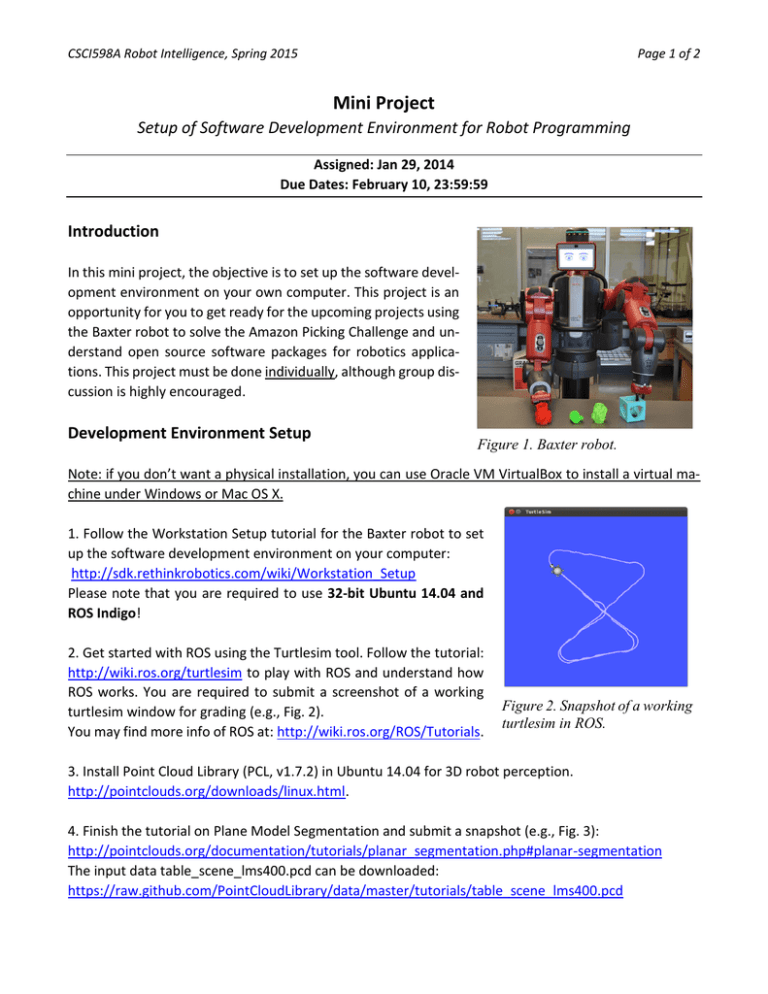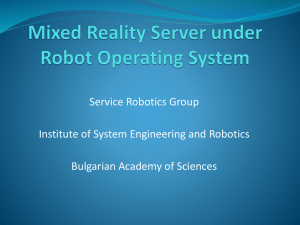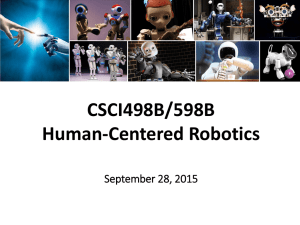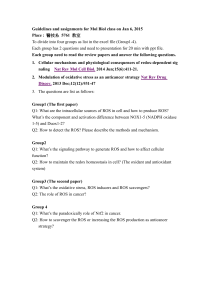Mini Project Setup of Software Development Environment for Robot Programming Introduction
advertisement

CSCI598A Robot Intelligence, Spring 2015 Page 1 of 2 Mini Project Setup of Software Development Environment for Robot Programming Assigned: Jan 29, 2014 Due Dates: February 10, 23:59:59 Introduction In this mini project, the objective is to set up the software development environment on your own computer. This project is an opportunity for you to get ready for the upcoming projects using the Baxter robot to solve the Amazon Picking Challenge and understand open source software packages for robotics applications. This project must be done individually, although group discussion is highly encouraged. Development Environment Setup Figure 1. Baxter robot. Note: if you don’t want a physical installation, you can use Oracle VM VirtualBox to install a virtual machine under Windows or Mac OS X. 1. Follow the Workstation Setup tutorial for the Baxter robot to set up the software development environment on your computer: http://sdk.rethinkrobotics.com/wiki/Workstation_Setup Please note that you are required to use 32-bit Ubuntu 14.04 and ROS Indigo! 2. Get started with ROS using the Turtlesim tool. Follow the tutorial: http://wiki.ros.org/turtlesim to play with ROS and understand how ROS works. You are required to submit a screenshot of a working turtlesim window for grading (e.g., Fig. 2). You may find more info of ROS at: http://wiki.ros.org/ROS/Tutorials. Figure 2. Snapshot of a working turtlesim in ROS. 3. Install Point Cloud Library (PCL, v1.7.2) in Ubuntu 14.04 for 3D robot perception. http://pointclouds.org/downloads/linux.html. 4. Finish the tutorial on Plane Model Segmentation and submit a snapshot (e.g., Fig. 3): http://pointclouds.org/documentation/tutorials/planar_segmentation.php#planar-segmentation The input data table_scene_lms400.pcd can be downloaded: https://raw.github.com/PointCloudLibrary/data/master/tutorials/table_scene_lms400.pcd CSCI598A Robot Intelligence, Spring 2015 Page 2 of 2 5. Install OpenCV 2.4.9.0 in Ubuntu 14.04 for 2D robot perception. 6. Finish the tutorial on Feature Detection using a Baxter robot picture and submit a snapshot: http://docs.opencv.org/doc/tutorials/features2d/feature_detection/feature_detection.html The Baxter picture that can be downloaded from: http://inside.mines.edu/~hzhang/Courses/CSCI598ASpring15/Projects/Project-1/BaxterCSM.jpg Figure 3. Snapshot of plane segmentation. Submission and Grading The Mini Project has a single due date: 23:59:59, February 10, 2015. The project report must be submitted to the Blackboard before the due time. Submission: The content required to be included in the submission is listed as follows: (1). 40/100: A snapshot of a working turtlesim in ROS under Ubuntu; (2). 25/100: A snapshot of plane model segmentation using PCL; (3). 25/100: A snapshot of feature detection results using OpenCV; (4). 10/100: Your ideas to apply these open source packages, including ROS, PCL, and OpenCV on Baxter robots to address the Amazon Picking Challenge. Report Guidelines: As part of your completed project, a report (1-2 pages) is required. Your paper must be formatted using LaTex and the standard 2-column IEEE conference paper format. File styles: http://www.ieee.org/conferences_events/conferences/publishing/templates.html An example of the paper format is available: http://inside.mines.edu/~hzhang/Courses/CSCI598A-Spring15/Projects/FormatExample.pdf






